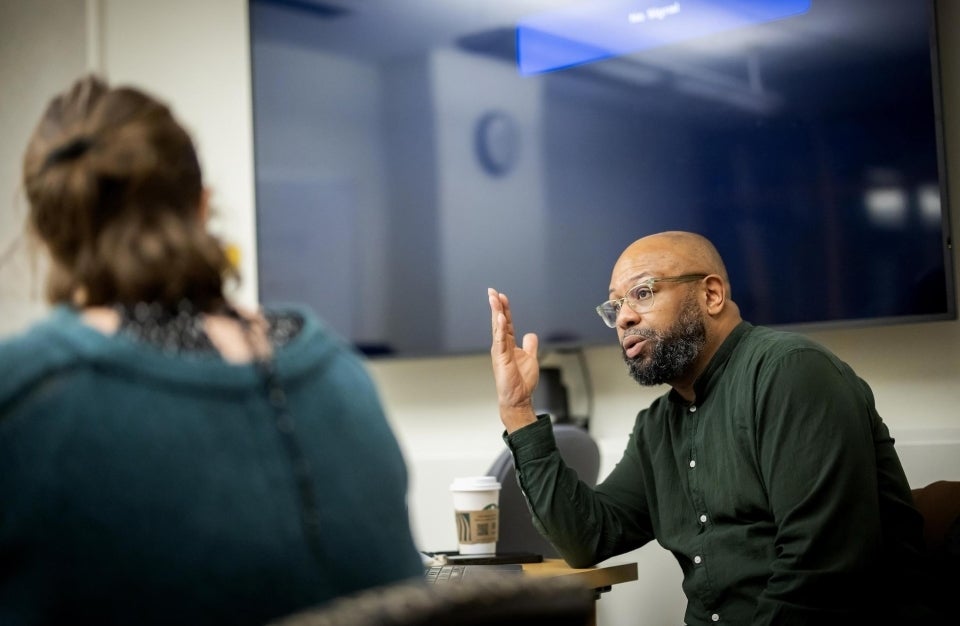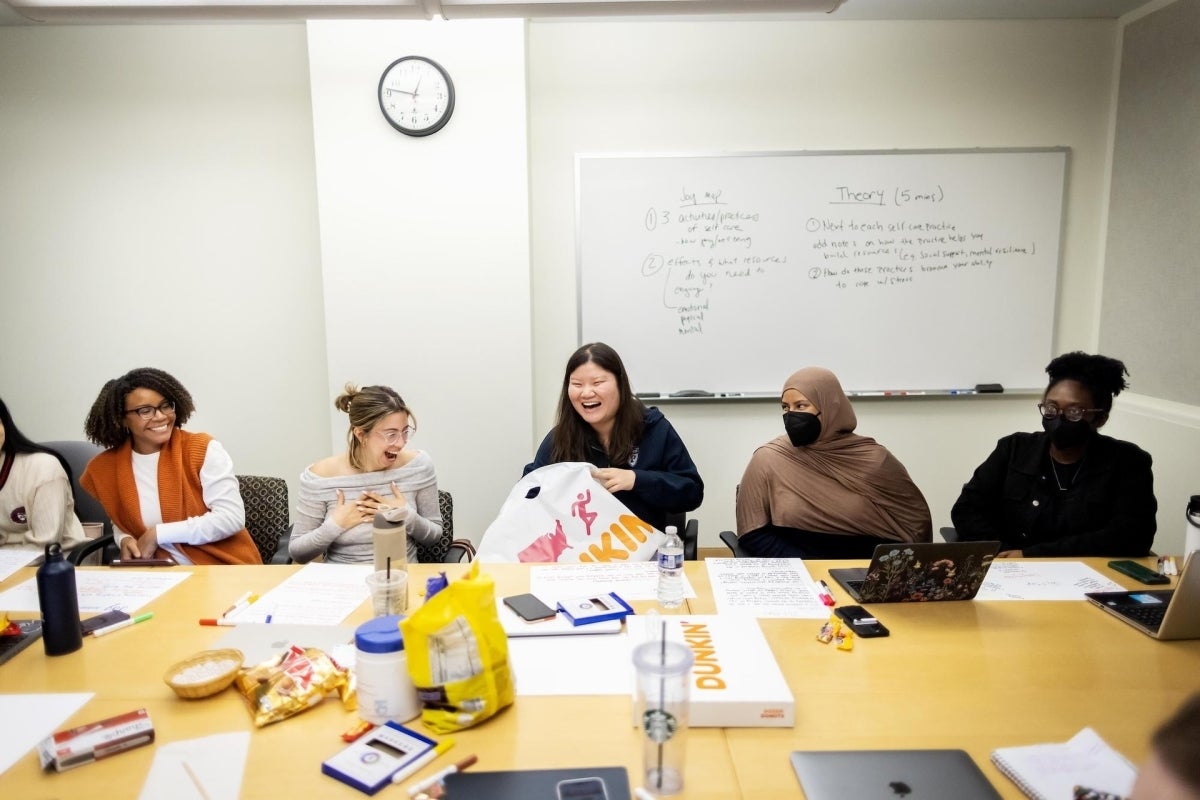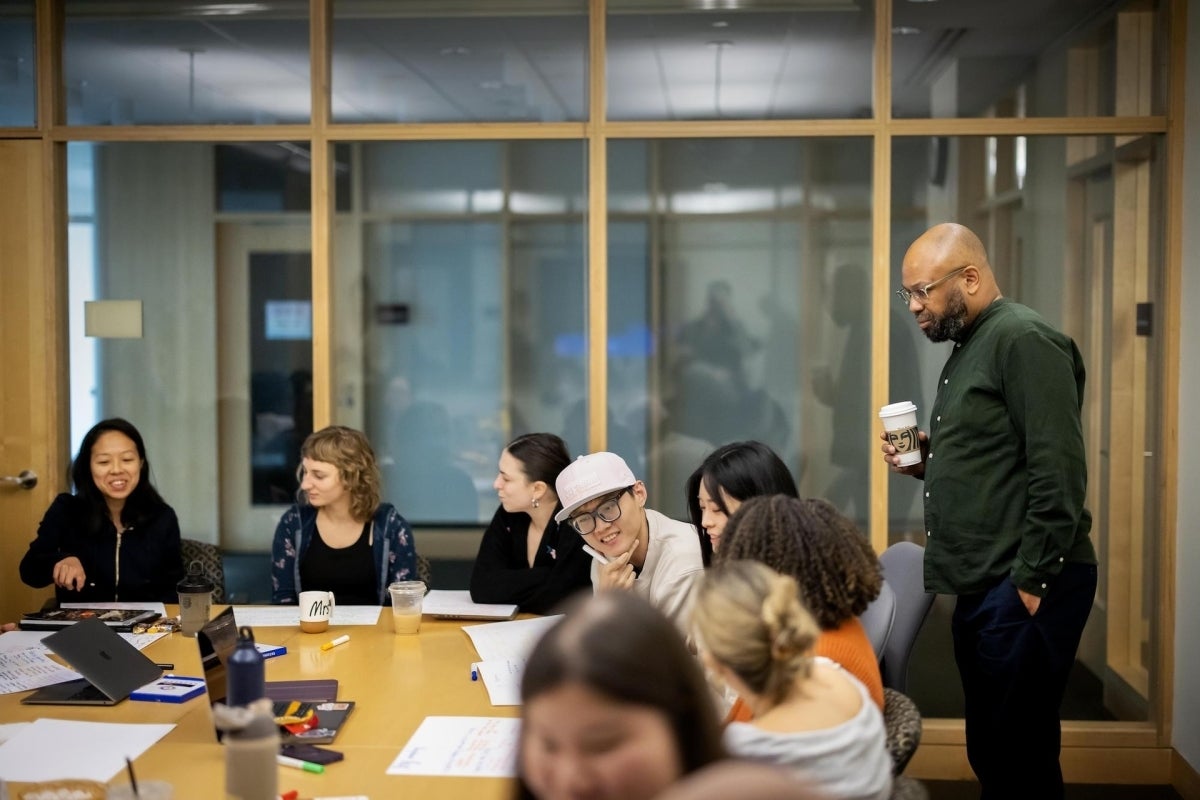Journey to Joy
In a joint class within Annenberg and the School of Social Policy & Practice - "Journey to Joy: Designing a Happier Life" - PIK Professor Desmond Upton Patton invites students to dream big.

Desmond Patton speaks with a student during the Journey to Joy class. (Photo: Eric Sucar)
Often, the status symbols society reveres are achievements or material goods: jobs and degrees; houses and cars; shoes and jewelry. But what does a well-lived life look like? What constitutes a productive life? Does that mean hitting milestones? Realizing goals? And on this journey, where does joy fit in?
In a joint class within the Annenberg School for Communication and the School of Social Policy & Practice, Penn Integrates Knowledge University Professor Desmond Upton Patton invites students to seek fulfillment in less tangible forms and dream big in "Journey to Joy: Designing a Happier Life."
“Joy, for me, is the ability to see and understand the future, the now, and your history—and how you can leverage that collective to have a meaningful and happy life,” Patton says. This is an especially important skill for graduate students going into social work, he says. “To be able to consider joy and the journey to joy as an everyday practice for your own self-care is critically important to be stay in this profession.”
Katrina Hertz is a master’s of social work student in her second year at Penn. Originally from Alabama, Hertz works with families, grief, and wellbeing and took the class intentionally to balance her practicum work. “There are a lot of conversations around grief and sadness and anger, but there are not a lot of conversations around joy,” she says. “I think the class was literally the dose of medicine that I needed to keep balanced this semester.”
The class is structured with scholarly readings along with suggested activities: experience art; attend a community event; spend time in nature. Students also keep a joy journal, making notes about their practice.
Students in the class say they learn through the readings that joy isn’t an isolated emotion of simple happiness. Joy is happiness in relation to purpose. Joy is also a social emotion, often experienced alongside other people in what the 19th-century sociologist Emile Durkheim called “collective effervescence.”
Joy Map
The course is designed to facilitate this experience. On one Wednesday afternoon, the group spread out at tables in an Annenberg classroom, working with magic markers on poster board to create “joy maps” as part of the theme for that week’s class: “Joy as a self-care practice.”
The notes and drawings that students make vary widely, in content and specificity. “Finding new music,” one wrote. “Making sweet potato fries,” wrote another. “My practice is water,” noted a third.
“You are building this concept of a joy map to reflect on self-care practice,” Patton told the class. Often, self-care is seen as trivial or frivolous, like a one-off spa day that seems indulgent at best. Patton asked students to break into small groups and discuss how their self-care practices connect to the readings and to offer insights on how these practices can act as a resource, both for the students as individuals, as well as for their larger communities.
One student shared that after stepping away for an hour to engage in a self-care practice, the stress that she returned to no longer felt as overwhelming. “One of the practices that I listed was getting my nails done,” she said. “After I do that and come back to the stress, like, ‘Oh, I’m a new woman!’”
“New woman, new nails!” Patton said, as the class laughed.
“I also talked about beauty maintenance,” another student added. Doing hair connects her with female relatives and ancestors, she said. “It affirms beauty, but also affirms my humanity. It makes me realize I am, not a body, but my body.”
While preferred self-care practices varied, several students talked about eating and sharing food. “Food is common ground for relationships,” one student said, as she reached under the table for a large box. “Talking about that, I did bring everyone donuts.”

“I love this class,” one woman said to her neighbor. “I know, right?” the other responded, helping herself to a donut.
While commonalities exist, there is high cultural variability amongst care practices, Patton noted, and a need to honor this variability. Sometimes it’s not easy to engage in self-care; sometimes culture also creates internal and external barriers.
“There’s a really big emphasis on family in the Latinx community,” one student shared. “Focusing on yourself, mental health, and therapy—to my mom, it looks like I’m being lazy. She doesn’t see that as an option for herself. Working was survival—this idea that you can’t slow down because you have to work. A lot of that has to do with the type of work that you’re doing, and you don’t have vacation days.”
Another student said that her culture also didn’t place a high value on self-care. “When you take the time to do so, you’re seen as weak or fragile,” she said.
“How do we balance conversations in this space?” Patton asked. “You want to balance understandings of self with cultural understandings,” he said. “It can’t be good for the family if it’s not good for you.”
“Joy isn’t just about you,” Patton said. “Joy can be an apparatus for you to think about your capacity, your container, your relationships, and effect your personalized joy has on family and community—how you connect, how you build relationships, how you sustain those relationships.”
Practicing Joy
Many cultural institutions were designed around work as a priority, said Levia Sutton, a second-year doctoral student at Penn Nursing enrolled in the course. “What are the structural implications of a joy practice? Imagine a world where that’s where we started, instead of productivity. How do you demonstrate that centering joy is, in of itself, generative?” she asked.
“Yes,” says Patton. “I truly think that it’s possible, but it requires a couple things: collective buy-in and an upstream approach.” This kind of work allows us to have conversations about how joyful culture can be an imperative part of an innovative and productive community, he said. “And I think joy can spark innovation, because it allows you to have a little bit more freedom in your head, to think and to imagine things that are not just about bad or good, but everything in between as well.”
Sutton is a second-year doctoral student at Penn Nursing studying trauma and violence exposure, particularly in Black women. She attended a lecture at Penn Nursing last year, “Can Technology Spark Joy and Imagination?” and realized that Patton’s work aligned with her own.
A certified registered nurse anesthetist, Sutton was often a witness to the aftermath of violence. She took succor in her work on trauma teams, providing life-saving care in those raw first moments of grief, Sutton says. But it didn’t answer her larger questions about the relentlessness of systemic violence and how to create change.
For her final class project, Sutton brought joy work to the Diversity in Nurse Anesthesia Mentorship Program, extending some of the joy pedagogy to this larger group at in-person conferences, including a wellness walk and a virtual experience “groove walking” with Dave Hem, who was also a guest presenter in Patton’s class.
As a wife and mother of three children, ages 11, 13, and 15, Sutton brings some of the class philosophy home, inviting her eldest child to reframe his thinking around a sports injury, for example, or creating time to dance and be silly as a family.
“My parents are immigrants. What I saw was work, and what I was told was, ‘Work in order to succeed,’” Sutton says. “Joy for me as a mother has come in that time when I’m reminding myself to slow down.”
Dreaming Joy
At the close of class, Patton invited students to develop a personal self-care plan, one they wouldn’t have to think about, wouldn’t take a lot of effort, and formalized rituals such as prayer, lighting candles, or swimming laps.
Then, he asked them to create a second, wildly ambitious self-care plan. For Patton, “a powerful manifester” whose care practice includes looking at the real estate website Zillow, that wild dream looks like a large house—someplace in the country, with woods and water and walking paths where he could host retreats and invite people for respite. “It’s fun to imagine,” he said.
“You can have a life that is imaginative and creative and even aspirational,” Patton said, as he urged students to uncouple their dream plan from any kind of timeline. “Embody who you are and who you want to be … I want you to go into hyper-imaginative space, with no worries about money, guilt, anything,” he said.

One student wrote about having chickens and an herb garden. “I’m not going to do that in my apartment in Philadelphia,” she said. Another student talked about her former life in Singapore. Her “dream self-care” was riding a motorbike around Asia, rock climbing, and scuba diving, but she’s happy to be at Penn because education fits into her goals. “For me, it’s a shift in practice rather than feeling like I’m lacking,” she said.
“It feels like you’ve engaged in healthy comparison to make you feel satisfied,” Patton said.
He then asked students to reflect on which plan was easier to create. For some, it was that dream plan. For others, it was the daily self-care guide. “I feel like I have been in survival mode,” one student said. “I haven’t had the time to think about dream things. I feel like this exercise helped me to think about things I haven’t thought about.”
The students Patton is training are all working in service of other people and thinking about communities, systems, institutions, and structures they want to change for the better, he says. “That is hard; it is complicated; it is challenging; and it can wear you down.
“What joy says is that you can hold out a little piece for yourself. That each and every day, even in the midst of things that you have no control over, that there’s something that you can envision, that you can manifest, that you can believe in, that you can use in order to feel good, to reimagine a world that may not see you for who you are. It is that thing that can make us wake up the next day—if we believe in it, if we can track it, if we can understand it,” Patton says.



